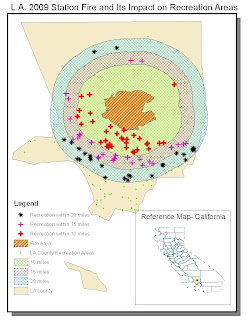
From August 26th to October 16th 2009, 251 square miles (160,577 acres) of the Angeles National Forest were burned in the larges forest fire in Los Angeles history and the 10th largest in California state history (http://inciweb.org/incident/article/9640/). The damage by the time the fire was contained included the lives of two firefighters and 89 homes and cost $93.8 million to battle (http://inciweb.org/incident/article/9640/). The fire threatened an additional 12,000 structures in the Angeles National Forest and the nearby communities of La Cañada Flintridge, Glendale, Acton, La Crescenta, Littlerock, Altadena, Sunland and Tujunga.
County Fire Department Capt. Jerry Meehan said that this fire was "the biggest ever" and that the flames could reach 300 to 400 feet high. Meehan also added that, "This is the hottest-burning, most damaging I've seen" (LA Times http://latimesblogs.latimes.com/lanow/2009/09/station-fire-is-largest-in-la-county-history.html). The starting of the fire is suspected to be arson, but still to this date no one has been charged. If someone is convicted, they face the possibility of a death sentence since the fire killed two firefighters.
While the Station Fire was extremely destructive in the 251 square miles that it scorched, the effects were felt well beyond just the burn-zone. Fire creates smoke and smoke is made up of water vapor but also harmful gasses and particulate matter like carbon monoxide, carbon dioxide, nitrogen oxide, irritant volatile organic compounds, toxic air pollutants and very small particles (http://www.deq.idaho.gov/air/prog_issues/burning/emerg_rule_fs.pdf). In smoke, the particles can build up in the respiratory system and case numerous health problems like burning eyes, runny noses, and bronchitis and can also aggravate existing heart and lung diseases like heart failure, chronic obstructive pulmonary diseases, emphysema, and asthma. It should be noted too that children and the elderly are more susceptible to the smoke caused by these fires and it is highly advised not to recreate near forest fires. (http://www.deq.idaho.gov/air/prog_issues/burning/emerg_rule_fs.pdf).
With the harmful effects to the body from smoke described above, it is easy to see why it is so harmful to recreate, or in extreme cases like this, even go outside into the environment when there is such an intense forest fire. The American Lung Associate states that: "If you live close to or in the surrounding area, it's recommended that you refrain from exercising outdoors, especially if you smell smoke or notice eye or throat irritation" (http://www.lungusa.org/healthy-air/outdoor/protecting-your-health/what-makes-air-unhealthy/forest-fires-respiratory-health-fact-sheet.html). In the above map, which shows the fire area and distances 10, 15, and 20 miles away in addition to all the recreation areas in Los Angeles County, it is definitely recommended for people who normally recreate within the buffer zones to stop for the duration of the fire. As you can see, a majority of the Los Angeles Country recreation areas lie within the 20 mile buffer, meaning that from August 26th to October 16th, a majority of Angelinos who normally frequent those spots either stopped recreating or braved the harmful effects of exercising in such close proximity to the fire. Even at UCLA during the fire, it was recommended by local health officials to not engage in heavy exercise routines to avoid respiratory aggravation.
The fire adversely affected recreation in Los Angeles Country from August 26th to October 16th 2009. Recreation is as much of a part of the Los Angeles lifestyle as anything in the region and fire not only affected people’s enjoyment of the outdoors, but their overall health. People were warned in the region not to recreate or even to go outside, thus reducing their overall physical abilities. Those that did choose to use the Los Angeles Country recreational areas during that time period risked suffering respiratory problems. In addition to the lost physical activity due to the station fire, local recreation areas were charred and now an effort is underway to replant the trees that were destroyed (http://latimesblogs.latimes.com/lanow/2010/04/replanting-begins-for-millions-of-trees-burned-in-station-fire.html). Millions of trees burned in the Station fire last August and local communities surrounding the fire zone are now taking on the task of restoring the ecosystem and their local recreation areas.
View of the fire from Downtown Los Angeles
BIBLIOGRAPHY:
Bloomekatz, Ari B. "Station Fire Is Largest in L.A. County's Modern History | L.A. NOW | Los Angeles Times." LA Times. 2 Sept. 2009. Web. 24 May 2010.
Idaho Department of Environmental Quality. Air Pollution Emergency Rule: What Is It, What Does It Do? Idaho Department of Environmental Quality. 23 Dec. 2004. Web.
"InciWeb the Incident Information System: Station Fire News Release." InciWeb the Incident Information System: Current Incidents. Web. 24 May 2010.
O'Neil, Megan. "Replanting Begins for Millions of Trees Burned in Station Fire | L.A. NOW | Los Angeles Times." LA Times. 11 Apr. 2010. Web. 27 May 2010.
United States of America. American Lung Association. Web. 23 May 2010.
United States of America. Idaho Department of Environmental Quality. Web. 24 May 2010.
No comments:
Post a Comment